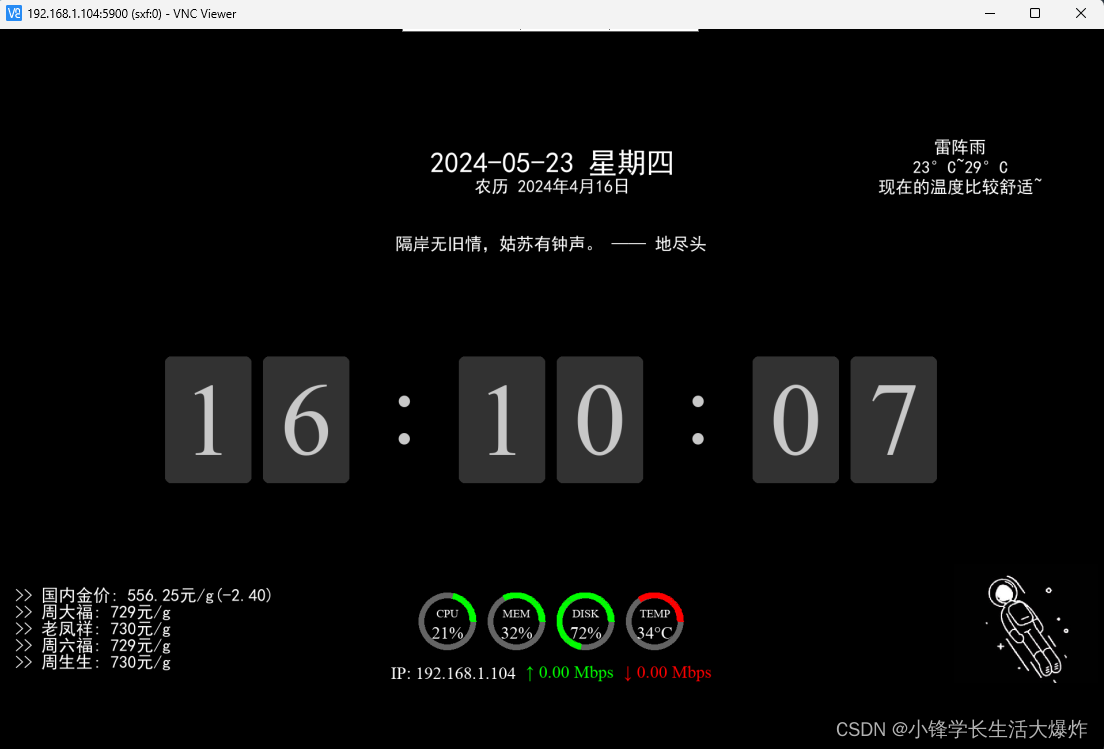【教程】超好看!Python制作桌面时钟屏保
目录
背景说明
运行效果
参考代码
背景说明
有一个空闲的jetson和13.3寸的屏幕,闲着也是闲着,拿来显示时钟好了(非jetson也可以用哦~)。浏览器显示在线时钟的方式直接占用80%的CPU,所以为了降低资源占用所以用Python写了个。
运行效果
有待添加更多内容(本来想想把魔镜加进来,但发现jetson有很多包装不上,就放弃了)。按esc按键可以退出全屏。

参考代码

icon-default.png?t=N7T8
https://github.com/1061700625/flip_clock_python
import pygame
import pygame.freetype
import time
import locale
import psutil
import requests
from lunarcalendar import Converter, Solar
import os
import math
import threading
import queue
# 设置中国时间和语言环境
locale.setlocale(locale.LC_TIME, 'zh_CN.utf8')
# 常量定义
BACKGROUND_COLOR = (0, 0, 0) # 背景颜色
DIGIT_COLOR = (200, 200, 200) # 数字颜色
FRAME_COLOR = (50, 50, 50) # 框架颜色
FRAME_PADDING = 10 # 框架填充
DIGIT_WIDTH, DIGIT_HEIGHT = 150, 200 # 数字宽度和高度
MARGIN = 20 # 间距
IP_INTERFACE = 'wlan0' # 网络接口
HITOKOTO_API = 'https://v1.hitokoto.cn/' # 一言API
WEATHER_API = 'https://api.vvhan.com/api/weather' # 天气API
IMAGE_PATH = 'tkr.jpg' # 图片路径
GOLD_PRICE_API = 'https://api.jinjia.com.cn/index.php?m=app&mi=0&cache=1' # 金价API
GOLD_PRICE_STORE_API = 'https://api.jinjia.com.cn/index.php?m=app&a=brand&mi=0&cache=1'
# 初始化Pygame
pygame.init()
pygame.freetype.init()
FONT_PATH = 'SimHei.ttf' # 字体路径
TIMES_NEW_ROMAN_PATH = 'times.ttf' # Times New Roman字体路径
class FlipClock:
def __init__(self):
# 初始化Pygame显示窗口
self.screen = pygame.display.set_mode((0, 0), pygame.FULLSCREEN)
self.width, self.height = self.screen.get_width(), self.screen.get_height()
self.x_start = (self.width - 8 * DIGIT_WIDTH - 7 * MARGIN) // 2
self.y_start = (self.height - DIGIT_HEIGHT) // 2 + 50
# 加载字体
self.fonts = self.load_fonts()
# 用于缓存渲染的文本
self.rendered_text_cache = {}
pygame.display.set_caption('Flip Clock')
# 隐藏鼠标指针
pygame.mouse.set_visible(False)
# 初始化变量
self.old_data = self.init_old_data()
# 记录上次绘制内容的矩形区域
self.rects = self.init_rects()
# 加载静态图片
self.image = pygame.image.load(IMAGE_PATH)
self.image = pygame.transform.scale(self.image, (250, 230))
self.image_rect = self.image.get_rect()
self.draw_image()
def load_fonts(self):
# 加载所有需要的字体
return {
'date': pygame.freetype.Font(FONT_PATH, 50),
'time': pygame.freetype.Font(TIMES_NEW_ROMAN_PATH, 180),
'lunar': pygame.freetype.Font(FONT_PATH, 30),
'digit': pygame.freetype.Font(TIMES_NEW_ROMAN_PATH, 180),
'ip': pygame.freetype.Font(TIMES_NEW_ROMAN_PATH, 30),
'hitokoto': pygame.freetype.Font(FONT_PATH, 30),
'usage': pygame.freetype.Font(TIMES_NEW_ROMAN_PATH, 30),
'label': pygame.freetype.Font(TIMES_NEW_ROMAN_PATH, 20),
'gold': pygame.freetype.Font(FONT_PATH, 30),
'weather': pygame.freetype.Font(FONT_PATH, 30)
}
def init_old_data(self):
# 初始化旧数据变量
return {
'time': "",
'date': "",
'lunar_date': "",
'ip': "",
'hitokoto': "",
'cpu_usage': 0,
'memory_usage': 0,
'disk_usage': 0,
'upload_speed': 0,
'download_speed': 0,
'cpu_temp': 0,
'gold_price': "",
'weather': ""
}
def init_rects(self):
# 初始化矩形区域
return {
"date": None,
"lunar_date": None,
"hitokoto": None,
"time": None,
"usage": None,
"network": None,
"gold_price": None,
"weather": None
}
def draw_flip_clock(self, data):
dirty_rects = []
self.update_text(data, 'date', dirty_rects, self.fonts['date'], (self.width // 2, self.height // 4 - 150))
self.update_text(data, 'lunar_date', dirty_rects, self.fonts['lunar'], (self.width // 2, self.height // 4 - 100))
self.update_text(data, 'hitokoto', dirty_rects, self.fonts['hitokoto'], (self.width // 2, self.height // 4))
self.update_flip_time(data, dirty_rects)
self.update_usage_circles(data, dirty_rects)
self.update_network_info(data, dirty_rects)
self.update_text(data, 'gold_price', dirty_rects, self.fonts['gold'], (30, self.height - 200), alignment='left')
self.update_text(data, 'weather', dirty_rects, self.fonts['weather'], (self.width-250, 80), wrapped=True, max_width=200)
return dirty_rects
def update_text(self, data, key, dirty_rects, font, position, wrapped=False, max_width=None, alignment='center'):
# 更新文本信息
if data[key] != self.old_data[key]:
if self.rects[key]:
self.clear_rect(self.rects[key])
if wrapped:
self.rects[key] = self.render_wrapped_text(font, data[key], position, max_width, alignment)
else:
self.rects[key] = self.render_text(font, data[key], position, alignment)
dirty_rects.append(self.rects[key])
self.old_data[key] = data[key]
def update_flip_time(self, data, dirty_rects):
# 更新翻页时钟
if data['time'] and (data['time'] != self.old_data['time']):
if self.rects['time']:
self.clear_rect(self.rects['time'])
self.rects['time'] = self.render_flip_numbers(data['time'])
dirty_rects.append(self.rects['time'])
self.old_data['time'] = data['time']
def update_usage_circles(self, data, dirty_rects):
# 更新系统使用率的圆环
if any(data[key] != self.old_data[key] for key in ['cpu_usage', 'memory_usage', 'disk_usage', 'cpu_temp']):
if self.rects['usage']:
self.clear_rect(self.rects['usage'])
self.rects['usage'] = self.draw_usage_circles(data['cpu_usage'], data['memory_usage'], data['disk_usage'], data['cpu_temp'])
dirty_rects.append(self.rects['usage'])
for key in ['cpu_usage', 'memory_usage', 'disk_usage', 'cpu_temp']:
self.old_data[key] = data[key]
def update_network_info(self, data, dirty_rects):
# 更新网络信息
if any(data[key] != self.old_data[key] for key in ['ip', 'upload_speed', 'download_speed']):
if self.rects['network']:
self.clear_rect(self.rects['network'])
self.rects['network'] = self.draw_network_info(data['ip'], data['upload_speed'], data['download_speed'], (self.width // 2, self.height - 50))
dirty_rects.append(self.rects['network'])
for key in ['ip', 'upload_speed', 'download_speed']:
self.old_data[key] = data[key]
def clear_rect(self, rect):
# 清除矩形区域
pygame.draw.rect(self.screen, BACKGROUND_COLOR, rect.inflate(10, 10))
def render_text(self, font, text, position, alignment='center'):
lines = text.split('\n')
y_offset = 0
max_width = 0
rects = []
for line in lines:
surface, rect = self.get_rendered_text(font, line, (255, 255, 255))
if alignment == 'left':
rect.topleft = (position[0], position[1] + y_offset)
elif alignment == 'center':
rect.midtop = (position[0], position[1] + y_offset)
elif alignment == 'right':
rect.topright = (position[0], position[1] + y_offset)
self.screen.blit(surface, rect)
y_offset += rect.height
max_width = max(max_width, rect.width)
rects.append(rect)
# Calculate the bounding rect for all lines
bounding_rect = pygame.Rect(position[0] - max_width // 2, position[1], max_width, y_offset)
return bounding_rect
def render_wrapped_text(self, font, text, position, max_width, alignment='left'):
# 渲染自动换行的文本
lines = self.wrap_text(font, text, max_width)
x, y = position
total_height = sum([font.get_sized_height() for line in lines])
y = total_height
rects = []
for line in lines:
surface, rect = font.render(line, (255, 255, 255))
if alignment == 'center':
rect.centerx = x
elif alignment == 'right':
rect.right = x + max_width // 2
elif alignment == 'left':
rect.left = x - max_width // 2
rect.top = y
self.screen.blit(surface, rect)
rects.append(rect)
y += font.get_sized_height()
return pygame.Rect(x - max_width // 2, y - total_height, max_width, total_height)
def wrap_text(self, font, text, max_width):
# 自动换行处理
words = text.split()
lines = []
current_line = []
for word in words:
current_line.append(word)
line_width, _ = font.get_rect(' '.join(current_line)).size
if line_width > max_width:
current_line.pop()
lines.append(' '.join(current_line))
current_line = [word]
if current_line:
lines.append(' '.join(current_line))
return lines
def render_flip_numbers(self, current_time):
# 渲染翻页时钟数字
flip_rect = pygame.Rect(self.x_start - 10, self.y_start - FRAME_PADDING - 10, 8 * DIGIT_WIDTH + 7 * MARGIN + 20, DIGIT_HEIGHT + 2 * FRAME_PADDING + 20)
for i, char in enumerate(current_time):
rect_x = self.x_start + i * (DIGIT_WIDTH + MARGIN)
if char.isdigit():
# 绘制背景框
pygame.draw.rect(self.screen, FRAME_COLOR, (rect_x, self.y_start - FRAME_PADDING, DIGIT_WIDTH, DIGIT_HEIGHT + 2 * FRAME_PADDING), border_radius=10)
# 绘制数字
digit_surface, digit_rect = self.get_rendered_text(self.fonts['digit'], char, DIGIT_COLOR)
digit_rect.center = (rect_x + DIGIT_WIDTH // 2, self.y_start + DIGIT_HEIGHT // 2)
else:
# 绘制冒号,不加背景框
digit_surface, digit_rect = self.get_rendered_text(self.fonts['digit'], char, DIGIT_COLOR)
digit_rect.center = (rect_x + DIGIT_WIDTH // 2, self.y_start + DIGIT_HEIGHT // 2)
self.screen.blit(digit_surface, digit_rect)
return flip_rect
def get_rendered_text(self, font, text, color):
# 如果文本未缓存,则渲染并缓存
if text not in self.rendered_text_cache:
self.rendered_text_cache[text] = font.render(text, color)
return self.rendered_text_cache[text]
def draw_usage_circles(self, cpu_usage, memory_usage, disk_usage, cpu_temp):
# 绘制系统使用率的圆环
usage_rect = pygame.Rect(self.width // 2 - 270, self.height - 200, 540, 120)
total_width = 4 * 120 # 每个圆环和标签的总宽度,包括间距
start_x = (self.width - total_width) // 2 + 60 # 向右移动半个圆环的距离
y = self.height - 140
self.draw_usage_circle(start_x, y, cpu_usage, "CPU", (0, 255, 0))
self.draw_usage_circle(start_x + 120, y, memory_usage, "MEM", (0, 255, 0))
self.draw_usage_circle(start_x + 240, y, disk_usage, "DISK", (0, 255, 0))
self.draw_temp_circle(start_x + 360, y, cpu_temp, "TEMP", (255, 0, 0))
return usage_rect
def draw_usage_circle(self, x, y, usage, label, color):
# 绘制使用率圆环
radius = 50
thickness = 10
start_angle = 0
end_angle = 360 * (usage / 100)
# 绘制背景圆环
pygame.draw.circle(self.screen, (100, 100, 100), (x, y), radius, thickness)
# 绘制前景圆环
pygame.draw.arc(self.screen, color,
(x - radius, y - radius, 2 * radius, 2 * radius),
math.radians(start_angle), math.radians(end_angle), thickness)
# 绘制标签文本在圆环的上方
self.render_text(self.fonts['label'], label, (x, y - 20))
# 绘制使用率文本
usage_text = f"{int(usage)}%"
self.render_text(self.fonts['usage'], usage_text, (x, y + 10))
def draw_temp_circle(self, x, y, temp, label, color):
# 绘制温度圆环
radius = 50
thickness = 10
start_angle = 0
end_angle = 360 * (temp / 100) # 假设最大温度为100°C
# 绘制背景圆环
pygame.draw.circle(self.screen, (100, 100, 100), (x, y), radius, thickness)
# 绘制前景圆环
pygame.draw.arc(self.screen, color,
(x - radius, y - radius, 2 * radius, 2 * radius),
math.radians(start_angle), math.radians(end_angle), thickness)
# 绘制标签文本在圆环的上方
self.render_text(self.fonts['label'], label, (x, y - 20))
# 绘制温度文本
temp_text = f"{int(temp)}°C"
self.render_text(self.fonts['usage'], temp_text, (x, y + 10))
def draw_network_info(self, ip_address, upload_speed, download_speed, position):
# 绘制网络信息
x, y = position
ip_surface, ip_rect = self.get_rendered_text(self.fonts['ip'], f"IP: {ip_address}", (255, 255, 255))
up_arrow = "↑"
down_arrow = "↓"
up_surface, up_rect = self.get_rendered_text(self.fonts['ip'], f"{up_arrow} {upload_speed:.2f} Mbps", (0, 255, 0))
down_surface, down_rect = self.get_rendered_text(self.fonts['ip'], f"{down_arrow} {download_speed:.2f} Mbps", (255, 0, 0))
total_width = ip_rect.width + up_rect.width + down_rect.width + 40
ip_x = x - total_width // 2
up_x = ip_x + ip_rect.width + 20
down_x = up_x + up_rect.width + 20
self.screen.blit(ip_surface, (ip_x, y - ip_rect.height // 2))
self.screen.blit(up_surface, (up_x, y - up_rect.height // 2))
self.screen.blit(down_surface, (down_x, y - down_rect.height // 2))
return pygame.Rect(ip_x, y - ip_rect.height // 2, total_width, max(ip_rect.height, up_rect.height, down_rect.height))
def draw_image(self):
# 绘制静态图片在右下角
self.image_rect.bottomright = (self.width - 10, self.height - 10)
self.screen.blit(self.image, self.image_rect)
class Utils:
@staticmethod
def gold_price_zh():
# 实时金价
msg = ''
try:
resp = requests.get(GOLD_PRICE_API).json()
gn = resp['gn'][0]
price = gn['price']
changepercent = gn['changepercent']
msg = f">> 国内金价: {price}元/g({changepercent})"
except Exception:
pass
return msg
@staticmethod
def gold_price_store(num=1):
# 实时金价
msg = ''
try:
resp = requests.get(GOLD_PRICE_STORE_API).json()
for i in range(num):
brand = resp['brand'][i]
title = brand['title']
gold = brand['gold']
msg += f">> {title}: {gold}元/g\n"
except Exception:
pass
return msg.strip()
@staticmethod
def get_time_strings():
# 获取当前时间
now = time.localtime()
return time.strftime('%H:%M:%S', now)
@staticmethod
def get_date_strings():
# 获取当前日期和农历日期
now = time.localtime()
current_date = time.strftime('%Y-%m-%d %A', now)
# 转换为农历日期
solar = Solar(now.tm_year, now.tm_mon, now.tm_mday)
lunar = Converter.Solar2Lunar(solar)
lunar_date = f"农历 {lunar.year}年{lunar.month}月{lunar.day}日"
return current_date, lunar_date
@staticmethod
def get_ip_address(interface):
# 获取指定网络接口的IP地址
try:
addrs = psutil.net_if_addrs()
return [addr.address for addr in addrs[interface] if addr.family == 2][0]
except Exception:
return "IP获取失败"
@staticmethod
def get_hitokoto():
# 从API获取一言
try:
response = requests.get(HITOKOTO_API)
if response.status_code == 200:
data = response.json()
return f"{data.get('hitokoto', '')} —— {data.get('from', '')}"
else:
return "无法获取一言"
except Exception:
return "一言获取失败"
@staticmethod
def get_system_usage():
# 获取系统CPU、内存和磁盘使用率
cpu_usage = psutil.cpu_percent(interval=1)
memory_info = psutil.virtual_memory()
memory_usage = memory_info.percent
disk_usage = psutil.disk_usage('/').percent
return cpu_usage, memory_usage, disk_usage
@staticmethod
def get_network_speed(interface):
# 获取网络接口的上行和下行速度
net_io = psutil.net_io_counters(pernic=True)
upload_speed = net_io[interface].bytes_sent
download_speed = net_io[interface].bytes_recv
time.sleep(0.1)
net_io = psutil.net_io_counters(pernic=True)
upload_speed = (net_io[interface].bytes_sent - upload_speed) * 8 / 1e6
download_speed = (net_io[interface].bytes_recv - download_speed) * 8 / 1e6
return upload_speed, download_speed
@staticmethod
def get_cpu_temp():
# 获取CPU温度
temp_file = '/sys/class/thermal/thermal_zone0/temp'
try:
with open(temp_file, 'r') as f:
temp = f.read()
return int(temp) / 1000 # 假设读取到的温度值是毫摄氏度,需要转换为摄氏度
except:
return 0
@staticmethod
def get_gold_price():
# 获取实时金价
try:
price_zh = Utils.gold_price_zh()
price_store = Utils.gold_price_store(num=4)
return price_zh+'\n'+price_store
except Exception as e:
print(e)
return "<金价获取失败>"
@staticmethod
def get_weather():
# 获取天气信息
try:
response = requests.get(WEATHER_API)
if response.status_code == 200:
data = response.json()
if data['success']:
weather = data['data']
return f"{weather['type']} {weather['low']}~{weather['high']}\n{data['tip']}"
else:
return "无法获取天气"
else:
return "无法获取天气"
except Exception:
return "天气获取失败"
def fetch_data(data_queue):
# 初始化数据
data = {
'hitokoto': Utils.get_hitokoto(),
'date': Utils.get_date_strings()[0],
'lunar_date': Utils.get_date_strings()[1],
'ip': Utils.get_ip_address(IP_INTERFACE),
'gold_price': Utils.get_gold_price(),
'weather': Utils.get_weather()
}
for key, value in data.items():
data_queue.put((key, value))
timers = {
'hitokoto': time.time(),
'date': time.time(),
'ip': time.time(),
'gold_price': time.time(),
'weather': time.time()
}
while True:
# 更新一言
if time.time() - timers['hitokoto'] >= 10:
data_queue.put(('hitokoto', Utils.get_hitokoto()))
timers['hitokoto'] = time.time()
# 更新日期和农历日期
if time.time() - timers['date'] >= 60:
current_date, lunar_date = Utils.get_date_strings()
data_queue.put(('date', current_date))
data_queue.put(('lunar_date', lunar_date))
timers['date'] = time.time()
# 更新IP地址
if time.time() - timers['ip'] >= 5:
data_queue.put(('ip', Utils.get_ip_address(IP_INTERFACE)))
timers['ip'] = time.time()
# 更新金价
if time.time() - timers['gold_price'] >= 60:
data_queue.put(('gold_price', Utils.get_gold_price()))
timers['gold_price'] = time.time()
# 更新天气信息
if time.time() - timers['weather'] >= 1800: # 更新天气信息的时间间隔为30分钟
data_queue.put(('weather', Utils.get_weather()))
timers['weather'] = time.time()
# 获取网络速度
upload_speed, download_speed = Utils.get_network_speed(IP_INTERFACE)
data_queue.put(('upload_speed', upload_speed))
data_queue.put(('download_speed', download_speed))
# 获取系统使用率
cpu_usage, memory_usage, disk_usage = Utils.get_system_usage()
data_queue.put(('cpu_usage', cpu_usage))
data_queue.put(('memory_usage', memory_usage))
data_queue.put(('disk_usage', disk_usage))
# 获取CPU温度
data_queue.put(('cpu_temp', Utils.get_cpu_temp()))
time.sleep(1)
def main():
clock = pygame.time.Clock()
flip_clock = FlipClock()
running = True
# 创建数据队列和线程
data_queue = queue.Queue()
data_thread = threading.Thread(target=fetch_data, args=(data_queue,), daemon=True)
data_thread.start()
# 初始化数据
data = {
'ip': " ",
'hitokoto': " ",
'upload_speed': 0.0,
'download_speed': 0.0,
'cpu_temp': 0.0,
'cpu_usage': 0.0,
'memory_usage': 0.0,
'disk_usage': 0.0,
'date': " ",
'lunar_date': " ",
'gold_price': " ",
'weather': " "
}
while running:
# 事件处理
for event in pygame.event.get():
if event.type == pygame.QUIT or (event.type == pygame.KEYDOWN and event.key == pygame.K_ESCAPE):
running = False
# 更新数据队列中的数据
while not data_queue.empty():
key, value = data_queue.get()
data[key] = value
# 获取当前时间
data['time'] = Utils.get_time_strings()
dirty_rects = flip_clock.draw_flip_clock(data)
pygame.display.update(dirty_rects)
clock.tick(30)
pygame.quit()
if __name__ == '__main__':
main()本文参与 腾讯云自媒体同步曝光计划,分享自作者个人站点/博客。
原始发表:2024-05-23,如有侵权请联系 cloudcommunity@tencent.com 删除
评论
登录后参与评论
推荐阅读
目录

